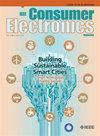CardioBERT:在消费者医疗保健中使用融合特征的心脏识别
IF 10.9
2区 计算机科学
Q1 ENGINEERING, ELECTRICAL & ELECTRONIC
引用次数: 0
摘要
心电图(ECG)读数在诊断心血管疾病(包括心肌梗死(MI))方面发挥着至关重要的作用,心肌梗死是一种严重损害心脏组织并可能导致致命后果的疾病。消费电子设备用于收集心电信号,这些信号揭示了心肌梗死的关键细节。及时准确的诊断对于降低死亡率至关重要,这可以通过使用ResNet等先进的深度学习模型来增强。本文介绍了CardioBERT,旨在利用卷积神经网络(CNN)和BERT等大型语言模型(llm)从心电信号中检测心血管疾病。由于CNN传统上是为多维数据构建的,而ECG信号本质上是一维的,因此我们的CardioBERT采用残差级接触映射预测来提取和优化集成特征,有效地解决了维度不匹配问题。此外,BERT通过捕获和解释数据中的复杂模式来丰富特征融合过程。通过使用消费电子和数学转换(例如,倒数和三次函数),CardioBERT与现有方法相比,精度提高了0.92%。这一改进强调了我们CardioBERT的潜力,通过llm增强,显著推进心血管医疗保健系统。本文章由计算机程序翻译,如有差异,请以英文原文为准。
CardioBERT: A Cardiac Identification Using Fusion Features in Consumer Healthcare
Electrocardiogram (ECG) readings play a vital role in diagnosing cardiovascular diseases, including myocardial infarction (MI), a condition that severely damages heart tissue and can lead to fatal outcomes. Consumer electronic devices are used to collect ECG signals, which reveal crucial details about MI. Timely and precise diagnosis is essential to reduce mortality, and this can be enhanced using advanced deep-learning models like ResNet. This paper introduces CardioBERT, designed to detect cardiovascular disease from ECG signals using Convolutional Neural Network (CNN) and large language models (LLMs) like BERT. Since CNN is traditionally built for multidimensional data, whereas ECG signals are inherently one-dimensional, our CardioBERT employs residue-level contact-map predictions to extract and optimally integrate features, effectively addressing the dimensionality mismatch. Furthermore, BERT enriches the feature fusion process by capturing and interpreting intricate patterns within the data. By employing consumer electronics and mathematical transformations (e.g., reciprocal and cubic functions), the CardioBERT achieves a notable 0.92% increase in accuracy with existing methods. This improvement underscores the potential of our CardioBERT, enhanced by LLMs, to advance cardiovascular healthcare systems significantly.
求助全文
通过发布文献求助,成功后即可免费获取论文全文。
去求助
来源期刊
CiteScore
7.70
自引率
9.30%
发文量
59
审稿时长
3.3 months
期刊介绍:
The main focus for the IEEE Transactions on Consumer Electronics is the engineering and research aspects of the theory, design, construction, manufacture or end use of mass market electronics, systems, software and services for consumers.

 求助内容:
求助内容: 应助结果提醒方式:
应助结果提醒方式:


